Theaters began showing director Autumn de Wilde’s Emma. (2020) in February 2020, just a month before the global pandemic forced the theater industry to reinvent itself. The film quickly tested the waters of pandemic streaming and video on demand as it became available through Amazon Prime and iTunes. De Wilde spoke of the film’s “palliative powers”; Variety called the film “cozy as hell—and perhaps a medicinal balm for anxiety” (Aurthur). Indeed, for many Austen fans and romantic comedy fanatics, the film satisfied the need for pandemic self-care and visual delight.
De Wilde’s team produced a gorgeous display, one that acknowledges the staged nature of twenty-first-century aesthetic values. Architectural Digest covered the film’s set design, reporting that “production designer Kave Quinn, set decorator Stella Fox, and their team” built Emma “a bright and colorful dollhouse” (Wallace). The colors of the final product speak to the way social media platforms run through faddish color palettes. In the film, this twenty-first-century trend translates into unified color coordination—that pale minty-green, pink, and yellow palette—that dominates visually rich scenes like the Hartfield drawing room during Mrs. Elton’s bridal visit, replete with towering confectionaries, pale pink cakes, and pastel roses to match.1
The details of mise en scène in Emma. align with a social media-savvy viewership. Many of the most appealing still images on Pinterest and Instagram require staging that resembles the rich display of edibles and consumer objects in the film. Viewers will remember the pastel and peach palette of Ford’s haberdashery in de Wilde’s Highbury. With gloves artfully placed and ribbon lengths perfectly matched, Mrs. Ford must employ someone devoted to exquisite staging—and with an eye for Pinterest shots. It is no surprise that a Google search for “Pinterest Emma 2020” gathers a healthy collection of sites that show fans’ fascination with de Wilde’s color scheme, costumes, and settings. Isabelle Kim-Sherman has written about the accuracy of the film’s costumes, so the visual popularity attests to a delightful blend of Regency faithfulness and 2020 color palettes.
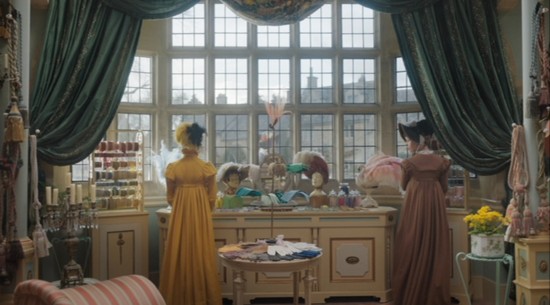
A pleasantly balanced scene from Mrs. Ford’s haberdashery just before Miss Bates’s arrival.
© 2020 Working Title Films
Speaking as a fan who made a day trip to the film’s location of Lower Slaughter during a 2022 trip across the Atlantic, I can attest to the captivating powers of the film’s imagery. However, the visuals alone did not produce the film’s impact on audiences. The project updates aspects of the characters’ relationships to make the story more attractive for modern audiences. To understand how de Wilde’s adaptation continues the process of modernizing Emma, viewers should consider the film’s depictions of class and its central female friendship. Emma. elevates the role of Highbury’s working class into that of well-placed observers with whom the other observers—the audience—can empathize. Indeed, at times the audience is invited to share the working person’s view of Highbury’s elite. While elevating the servants as observers, the film also advances Harriet and Emma’s friendship to a more honored relationship, one that briefly supplants the romantic heteronormative romance as a motivating factor for Emma’s actions.
Footmen on the periphery: Stealing the scene
De Wilde’s adaptation illuminates the role of the servants in the wealthy homes of Highbury to much comedic effect. These servants’ performances upend the delicate silence about servants that Sarah Dredge finds in the novels. Dredge argues that the “genteel central characters . . . maintain[ ] the illusion that servants neither see nor hear the private conversations” that motivate the plot. In the novels, servants are “invisible insiders” and politely ignored “witnesses” (Dredge).
Instead of remaining invisible, the servants in de Wilde’s film operate on the periphery yet catch the viewer’s eye. In a post-Downton Abbey era that values the stories of the downstairs as much as the stories of the upstairs, these servants silently convey their perspectives to the audience. The servants are more than a running gag. They represent an entire class of Highbury residents well placed to observe and to judge the people of leisure. The audience watches them dance around their wealthy employers, dressing them, screening them, appraising them. The servants’ occasional incredulity, their reasonable reactions to their employers’ nonsense, transforms them into trusted guides through this gorgeous but terribly privileged world.
Austen’s novel names servants without giving them much of a role to play: Mr. Woodhouse worries about his coachman, James, and praises his cook, Serle. The citizens of Highbury talk about Knightley’s servants William Larkins and Mrs. Hodges, but these managerial employees remain offstage. Past adaptations of Emma have engaged with the servant characters in varying degrees. William Phillips and Louise Heal see far greater engagement with class issues in Diarmuid Lawrence’s Emma (1996) when compared to Douglas McGrath’s Emma (1996). O’Hanlon’s Emma (2009) puts little emphasis on the serving classes.
Right from the start of Emma., viewers are taught to consider the role of people in service. The footman Bartholomew and an unnamed maid accompany Emma to the hothouse, where she points languidly to flowers for the maid to cut. Bartholomew stoically lights Emma’s way by holding a lantern on a stick. In the brief interchange, Emma avoids making eye contact with either character, a trait Anya Taylor-Joy’s Emma tends to exhibit when she is performing as first lady of the neighborhood.
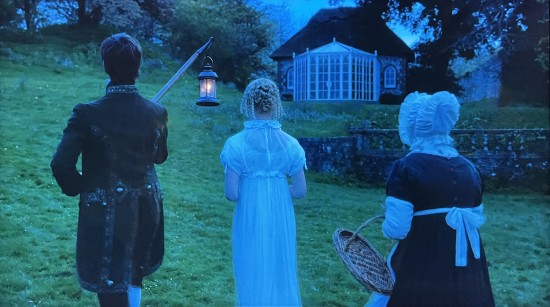
Two servants accompany Emma to create a bouquet. © 2020 Working Title Films
Two scenes later, viewers watch as six servants ready the two Woodhouses for Miss Taylor’s wedding. The footmen, maids, and coachman perform an intricate dance around the Woodhouses, who, in turn, take for granted their servants’ ability to be where they are expected to be.
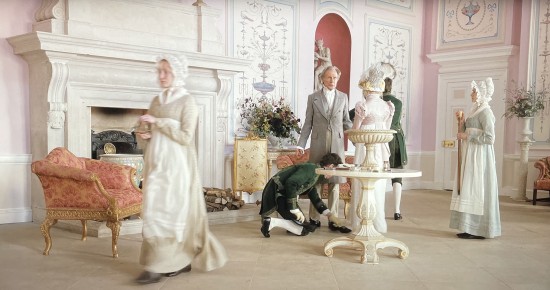
Several servants ready Mr. Woodhouse for his outing to Miss Taylor’s wedding.
© 2020 Working Title Films
De Wilde’s approach to Highbury’s workers adds more comedy than previous Austen adaptations have attempted. The 2020 film bestows names on two previously unnamed footmen—Bartholomew and Charles—christening them as more fully formed characters. While these servants remain largely silent, they do express themselves through eloquent glances and body language. Fans of the BBC’s Pride and Prejudice (1995) will recall Mrs. Hill’s silent but physically expressed exasperation with Mrs. Bennet. De Wilde has expanded this sight gag. Looks pass between Bartholomew and Charles after their employer sends them scurrying to find the breezy draft in the breakfast room.

The footmen looking for the draft that bothers Mr. Woodhouse share a quick glance of annoyance. (Click here to see a larger version.)
© 2020 Working Title Films
Mrs. Ford, the seamstress and Highbury shopkeeper, gives Emma a scornful side-eye when she thoughtlessly moves her gown during a fitting. A Donwell Abbey footman enters and then exits a room when he finds Knightley lying on the floor in emotional distress. In that moment, viewers are invited to move away from analyzing Knightley’s love problems to considering the experience of the servants functioning around the edges of Austen’s story. In this and similar scenes, Emma. establishes an ironic cinematic gaze, one that invites audiences to see what the privileged characters fail to see.
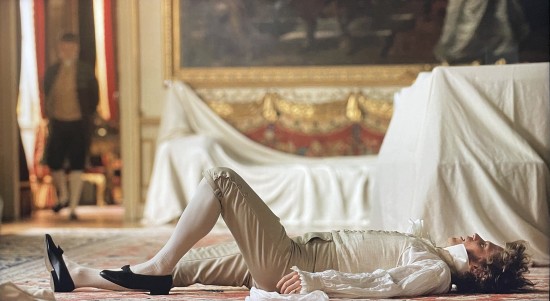
A footman observes his distraught employer and leaves the room. © 2020 Working Title Films
During Emma and Knightley’s indoor scene following the proposal, Bartholomew and Charles assess the intimate situation and decide to turn their backs on the kissing couple. Viewers are invited to consider how much agency servants have as they serve the leisured people of Highbury. The delicate interplay reminds the audience of all the preceding servant interactions that have humanized these silent characters. The footmen have learned to read the Woodhouses; they have found a way to balance their duties—standing within earshot of Mr. Woodhouse—with their embarrassment in witnessing their mistress’s unfolding romance. Ironically, the two lovers pay the servants no mind, no doubt a comment on how even a somewhat egalitarian Knightley and a reformed Emma continue to have blind spots promoted by their privilege.
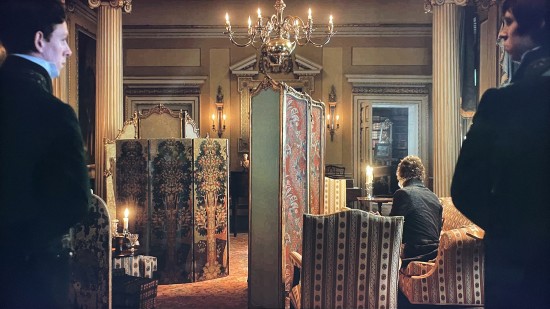
Bartholomew and Charles silently decide to give their mistress and Knightley privacy.
© 2020 Working Title Films
The film offers two other important interactions with servants, one silently expressive and the other dependent on dialogue. The film shows paired dressing scenes early on, one with Knightley’s valet undressing and redressing a briefly nude Knightley. In the other, Emma’s maid readies her for the day then walks away as Emma takes a brief moment of privacy to pull up her dress to warm her hidden backside in front of the fire. In the Donwell Abbey scene, the male figure is on display in what feels like an acknowledgement of Austen fandom’s deep enjoyment of Darcy’s wet shirt scenes in the 1995 Pride and Prejudice. Nicholas Barber writes about the impact of the scene Andrew Davies created: “Ever since, it seems, the makers of every new BBC costume drama have included their own tribute to this moment.” In de Wilde’s film, the two revealing scenes emphasize the characters’ sensuality while also establishing their humanity through completely mundane experiences: dressing and seeking the pleasant warmth of a fire. After these character-based establishing shots, the film returns to exhibiting Emma and Knightley in their public, Highbury personas.
Both dressing scenes remind viewers that the main characters’ gorgeous costuming depends on the labor of workers who have access to their employers’ vulnerable moments of nudity and social deactivation when the genteel characters are not actively performing their roles for their Highbury peers. More could be said about the film’s intentional imbalance between the film’s depiction of male nudity and the mere suggestion of female nudity. Sabrina Maddeaux has written about the present cultural moment of male objectification vs. the history of the male gaze and the long history of cinematic objectification of the female form. Maddeaux argues that “there’s no equivalent to the ‘male gaze’”: “Men simply don’t share the same historical struggles or risks that women do when it comes to being objectified. . . . Male objectification isn’t threatening because men don’t suffer from a severe power imbalance that puts them at risk economically, socially and physically.” In a production powered by female artists—from the director to the screenwriter to the composer—this intentional leveling plays well with the contemporary audience and the context of a 2020 release.
The second, more verbal servant–employer interaction shows the now fully dressed Mr. Knightley having a discussion with his housekeeper, Mrs. Reynolds.2 She chides him about performing the role of a gentleman: Mrs. Reynolds wants him to use his carriage, but he prefers to walk to Hartfield. We see Knightley’s respectful disagreement with his housekeeper, and the scene expresses both Knightley’s preference for avoiding frills and his courteousness to his subordinate. The Donwell Abbey sequence shows that this Knightley makes more eye contact with the working people of Highbury than the Woodhouses do in similar situations.
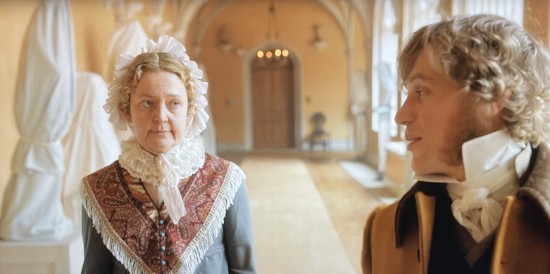
“A gentleman on foot is unusual,” Mrs. Reynolds tells Knightley.
© 2020 Working Title Films
Elevating the friend plot
The film’s attention to the servants aligns with its depiction of Emma’s evolving reactions to class differences. De Wilde’s Emma. joins the recent adaptations in updating one of Austen’s plot points that feels out of sync with modern feelings: the rejection of the novel’s central female friendship.
In Austen’s novel, Emma learns to devalue her friendship with Harriet when she fears that Harriet might stand in her way as the object of Knightley’s affection. After Harriet shares her romantic hopes about Knightley, Emma becomes “acquainted with her own heart” (444); thereafter, the heroine alters her interactions with Harriet in several ways. Emma entirely regrets the connection—“‘Oh God! That I had never seen her!’” (448)—and labels her own actions in promoting the relationship as “mischief” (449). Emma even decides that she should have befriended Jane Fairfax instead of Harriet Smith and laments the mistake: “had she endeavoured to find a friend there instead of in Harriet Smith; she must, in all probability, have been spared from every pain which pressed on her now.—Birth, abilities, and education, had been equally marking one as an associate for her, to be received with gratitude; and the other—what was she?” (458).
In the novel, Emma works to bring about distance in her relationship with Harriet. Emma sends a letter asking “decisively” for space after Harriet shares her belief that Mr. Knightley returns her affections (454). As a result, Harriet stays away from Hartfield. A second letter conveys Emma’s new understanding with Knightley, both gently informing Harriet and pushing her further away (474–75). Harriet acquiesces to this new distance, and Emma procures her an invitation to her sister’s home in London. Harriet “must now be even excluded from Hartfield. The delightful family-party which Emma was securing for herself, poor Harriet must, in mere charitable caution, be kept at a distance from. . . . Harriet would be rather a dead weight than otherwise” (490–91). Once Harriet is out of the neighborhood, Emma feels lighter: “Now Emma could, indeed, enjoy Mr. Knightley’s visits; now she could talk, and she could listen with true happiness, unchecked by the sense of injustice, of guilt, of something most painful, which had haunted her when remembering how disappointed a heart was near her” (492–93). Austen’s Emma wishes to curb the sympathetic feelings she has developed for Harriet.
The women’s relationship falls so far to the side that Emma learns of Harriet’s engagement to Robert Martin not from Harriet, but from Knightley. Although Emma later welcomes Robert Martin and Harriet to Hartfield, readers learn that “Harriet . . . was less and less at Hartfield; which was not to be regretted.—The intimacy between her and Emma must sink” (526). Rather than establishing the friendship as enduring, the novel shows it to be part of Emma’s past.
To fans of modern romantic comedies, the final rejection of the female friend strikes the wrong chord. Critics have long tried to make sense of the novel’s dismissal of Harriet. Carol M. Dole has called Emma’s “disposal of Harriet” as “the most problematic passage of the novel” (69). In the novel Emma, the ending suggests that women’s friendships, in Laura Thomasen’s words, “take second place” (238).
Film adaptations of Emma from the last three decades have rectified the female-friend plot point in consideration of audiences’ modern values. These audiences, made up of people trained on feminist perspectives and twenty-first-century rom coms, expect to see the female lead involved in authentic friendships as well as a love match. To achieve this friend-based harmony, adaptations of Emma must adjust the novel’s final class divides. The concluding scene in Clueless (1995) shows Cher, the Emma character, and Tai, the Harriet character, sitting at the same table at their teachers’ wedding. The concluding tableau suggests a continuation of their friendship and new harmony between the classes/cliques in Cher’s world. McGrath’s Emma (1996) “erases” Emma’s “disposal” of Harriet; Dole argues that “Nothing in this version suggests that difference in rank will ultimately separate the two women” (69). The made-for-television Emma (1996) directed by Lawrence shows Emma inviting Robert Martin and his family to visit her at Hartfield. It ends on a harvest-home country dance at Donwell Abbey in which Emma, Jane Fairfax, and Harriet all dance with their lovers in a final signal of equality—much to Mrs. Elton’s dismay. William Phillips and Louise Heal find that the McGrath and Lawrence films “depart . . . substantially” from Austen’s original plans for the previously doomed friendship, most likely because the “rigid class distinctions of Regency England would be too much for a general film audience in contemporary democratic English speaking societies to handle.”
Only Jim O’Hanlon’s Emma (2009) displays high fidelity to the original text in regard to the female friendship. In that adaptation Ramola Garai’s Emma says, “I wish to God I had never met her.” In a later scene the two characters interact briefly at Harriet’s wedding, but they fall far short of reestablishing their close intimacy: Harriet is beckoned away by Robert Martin, and she willingly leaves Emma behind.
Deanna K. Kreisel has written that Austen’s novels center on relationships between young women, be they sisters, friends, or false friends, often giving the friend/sister relationship significant focus (222). That type of relationship plays well in recent films in which protagonists have learned to embrace their female communities, often ending surrounded by friends rather than isolated with the lover. Thus, updating the Harriet plotline may show a nuanced type of fidelity to Austen’s oeuvre.
Putting friends before lovers
De Wilde’s film amends Austen’s original betrayal of feminine friendship. The film’s declaration-of-love sequence continues the elevation of the friend plot in accordance with twenty-first-century values and in direct contrast with the original Emma’s concerns. In the novel, Emma hears Knightley’s declaration and feels thankful that she has protected the secret of Harriet’s infatuation: “there was time also to rejoice that Harriet’s secret had not escaped her, and to resolve that it need not and should not” (469). Harriet does not otherwise feature in the lovers’ discourse. Emma., however, elevates the Harriet–Emma friendship to the point that, during the nosebleed scene, Emma chooses her friend over her own happiness. In the long pause after the proposal, Emma’s internal deliberations appear to spike, taking shape in the bursting of a blood vessel that causes the nosebleed. Emma disrupts the image of the picturesque romance with this nosebleed and by crying out, “No! I cannot! . . . Harriet! She’s in love with you!” As a symbol of stress, the nosebleed works well, representing Emma’s conflict in choosing between the man she loves and the friend she loves. In de Wilde’s film, Emma prioritizes her female friendship over her love story. Rather than sending Harriet away and re-establishing a separation between the classes, Taylor-Joy’s Emma shows the protagonist’s new humility.
The score behind the nosebleed scene emphasizes Emma’s authenticity here. An intense, allegro piece plays during the lovers’ initial debate. The violins swell, creating an effect that seems to belong to a chase scene in a silent film rather than a proposal scene. The music’s tension builds to an expectant pitch then resolves when Emma commits to repair the damage she has done: the score changes, and fermatas and single instrumental notes indicate Emma’s resignation. Vanderberg has shown that the sound track “create[s] internally persuasive discourses that represent some of Emma’s nastier moments as either comic or well-meaning, and her eventual repentance as sincere and profound.” The score helps audiences to understand that Emma’s choice shows her growth in character. Motivated by repentance of former actions, Emma feels that she must attempt to secure Harriet’s happy ending before seeking her own. She delays answering Knightley’s proposal during the nosebleed scene, and, when Knightley offers to go to Robert Martin and rekindle the Harriet–Robert romance, this Emma resignedly takes on a task she would clearly rather avoid: “No. I must do it. I must go.” This Emma demonstrates her transformation by visiting the farmer she formerly scorned, humbling herself and apologizing to Robert Martin. During Emma’s contrite speech, she amends her words and emphasizes that Harriet is “my dearest friend.”
The film quickly settles Harriet’s affairs, and Emma learns of the news in a way that once again elevates the women’s friendship. Harriet comes into Emma’s bedroom, and there the two women make amends. This scene promotes the women’s emotional intimacy as their body language reveals a new power balance between them followed by a heartfelt embrace. It is only after Harriet reveals her engagement to Robert Martin that the film’s Emma officially accepts Knightley’s proposal.
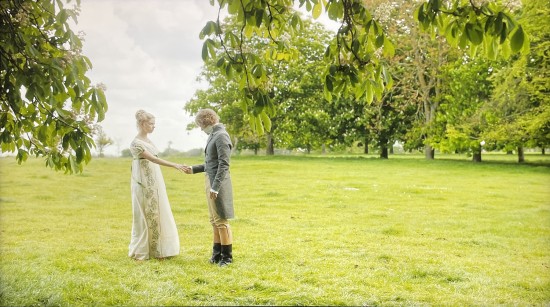
“I must go,” Emma says, and hands over the handkerchief before departing on her mission.
© 2020 Working Title Films
What would this Emma have done if her gift of a goose and her apology to Robert Martin had failed to rekindle the Harriet–Robert romance? It seems unlikely that Emma would have rejected Knightley’s proposal irrevocably just to save her friend’s disappointment. This Emma, however, sees it as an ethical imperative to attempt at least to settle Harriet’s future before settling her own. In this adaptation the Harriet problem replaces the Mr. Woodhouse problem; Emma’s reluctance to be separated from her father is dealt with smoothly and with little drama in de Wilde’s Emma. Viewers can still see some of Emma’s desire to control the narrative in her conciliatory visit to the Martin farm, but that impulse to control is easily overlooked since Emma must humble herself to take the steps needed to achieve her goal.
It would perhaps be overemphasizing the sequence to say that de Wilde’s Emma privileges the feminine affection above the heterosexual romance. After all, the film ends with a kiss and a wedding, and Emma centers herself in her new romantic relationship. De Wilde’s storytelling, however, elevates the women’s friendship in a new way, one in keeping with modern feminist sensibilities. Audiences expect the female protagonist to maintain and strengthen her female friendships even while she secures her love interest. She cannot sacrifice her friend for her lover.
The film’s version of events does highlight aspects of the novel’s final friendships. The film’s elevation of the friendship helps us to see how isolated Austen’s Emma is in her marriage. In the novel, although Emma attends Harriet’s wedding, Emma and Harriet do not retain their close connection: “their friendship must change into a calmer sort of goodwill; and, fortunately, what ought to be, and must be, seemed already beginning, and in the most gradual, natural manner” (526–27). Emma is unlikely to become friends with Jane Fairfax, despite the women’s sudden openness to each other, due to Jane’s removal from the neighborhood. In the novel, the married Emma’s circle of female friends will be smaller, not larger than that she enjoyed in her unmarried state.
In Emma., the friends’ final one-on-one meeting concludes the arc of this adaptation’s subplot with another new plot point: Emma bolsters her friendship with Harriet by inviting Harriet’s father to Hartfield. In the novel, Harriet’s father reveals himself, but Austen’s text does not suggest that Emma will ever meet him. In contrast, the film’s Emma proves her greatest character change by accepting Harriet’s whole identity: her illegitimacy, her status as a tradesman’s daughter, and her alliance with a farmer. Once her relationship with Harriet is righted, this rom-com protagonist shows the full spectrum of her character development.
NOTES
1The high concentration of sugar-dependent confectionary prepared for five people attests that Hartfield is not a home interested in the sugar boycotts that were part of the late eighteenth- and early nineteenth-century abolitionist movement in Britain. The decadent sugar culture on display reminds viewers that iconic country house excess was built on the backs of enslaved laborers in the West Indies and British Guiana. Viewers will note that this sugar-saturated scene in de Wilde’s film is designed to host Mrs. Elton, a character whom Kerry Sinanan identifies as “clearly linked to Bristol trade boosted by slavery” (9).
2The 2020 Emma. includes at least two Easter eggs related to the 1995 Pride and Prejudice: Lucy Briers, who plays Knightley’s housekeeper, also played Mary Bennet in the 1995 adaptation. In Austen’s novel Donwell Abbey’s housekeeper is named Mrs. Hodges, but here de Wilde uses the name of Pemberley’s housekeeper, Mrs. Reynolds, transporting her to Donwell Abbey. Emma wears a cross necklace very similar to those worn by the Bennet sisters. Although the Jane Austen Centre in Bath sells replicas of these iconic items as the “Elizabeth Bennet” cross, it’s similar to the crosses given to Jane and Cassandra Austen by their brother Charles, in the collection of Jane Austen’s House.
